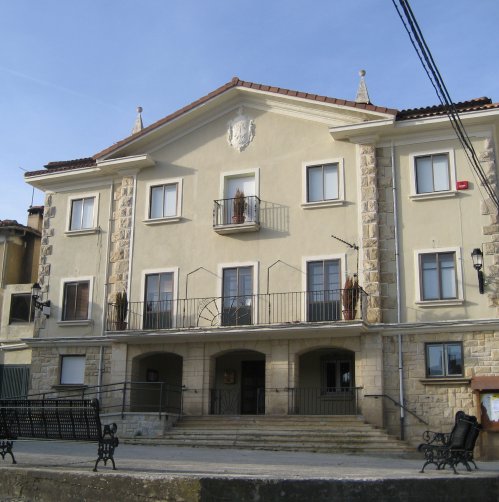The town of Lezáun is located at the foot of the Andía mountain range in its southern part. It is located to the northern edge of the Estella region. Its karst landscape a distinctive feature of the mountains, surrounded by simas and caves.
Its name is in Basque and means: Lezáun – Leza (cave) un (site). The site of the cave.
Its northern border Zunbeltz and Andía, to the south of the Yerri Valley and Abárzuza; and east the Guesálaz Valley.
Lezaun

The history of Lezáun as a City Hall is recent; it is a little more than 55 years. It became independent from the city Council of the Yerri Valley in 1951. It could be said that its traditional history, it was a village of shepherds; because of its municipality it is mainly pastures and forests. It is also noteworthy the importance of historical and artistic heritage:
- There are several emblazoned houses, important mansions very well preserved by their owners. One of the most important examples is “Casa Subiza” from the Parish of San Pedro (XII century) which had an extension in the XVII century and has a medieval tower with important patrimonial, historical and cultural value.
- The Chapel of Santa Bábara (Santa Barbara) is located to the southwest of the city centre, and is in very well conserved.
- The Chapel of San Cristobal (Saint Christopher) is of medieval origin, specifically the XXII century and is also well conserved.
- One of the families from Lezáun, the Azpilikueta family, is the immediate family to San Francisco Javier (Saint Francis Xavier – the co-patron Saint of Navarre) and it is said that the Saint occasionally visited. In fact, the tutor of Xavier was Martín de Azpilikueta (from the family of Mary Azpilikueta, mother of Xavier), was from Lezáun.
Interesting facts
- “Cueva del Cerro Viejo” (Old Cave Hill): The term Lezáun and in one of its many caves they have found prehistoric remains. Specifically, in the cave “Cerro Viejo” (Old Cave Hill), was used as a burial site.
- “Noticias medievales” (Medieval News): In 1209 Don Miguel de Laniz, made donations of fields and workers that he owned in Lezáun and Iriberri to the Irache Monastery. The work is stated in the document AGN (BEC.Go., F. 100r-101r). In this document it is written Leçaon and Fefaun. Apparently, the will was cited 17 March 1203 (cfr. J.M. Lacarra: Irache Diplomat Collection, Volume I, page 245)
- “Guerrillas en el siglo XIX” (Guerrilla in XIX century): In early November 1811, the division of the guerrillas of Francisco Espoz and Mina went through Lezáun, from Santa Cruz de Campezo and Guipúzcoa. The guerrillas were heading towards Sangϋesa, as Espoz and Mina had received a letter from General Blake, ordering to undertake the incursions they could in the region of Aragón.
- “Roturación del común (1931)” (Ploughing the public land in 1931): The Council of Lezáun had been requesting land concessions for a long time, located between the beech grove and the house of walkers, near the fountain of Artuxulo and the Venta de Zumbeltz. The Council granted permission in November 1931 to farm and share 275 “robadas” (it is the measurement used in Navarre, equivalent to 898,4560m² ) of the public land, awarding each neighbour 2 “robadas”. The Union of Initiatives and Tourism of Estella complained and denounced the Council as endangering one of the most beautiful the beech groves of Navarre, that form part of a Natural Park worthy of preservation.
Flora and fauna
There are protected species of great interest in Lezáun such as:
- Tritón alpino (Triturus alpestris) The Alpine Newt
- Quebrantahuesos (Gypaetus barbatus) The bearded vulture. The park is within the expansion area of the Plan of Recovery of this species
The main tree species are beech (Fagus sylvatica) and Field Maple (Acer campestre).
There are secondary tree species: Holly (llex aquifolium L.), European Yew (Taxus baccata L.), lime trees (Tilia platyphyllos Scopoli), ash tree (Fraxinus excelsior L) and oak trees (Quercus spp.) and wild fruit trees.
In Lezáun you can enjoy a large number of trails and paths of great interest such as “El Hayedo de Lezáun” (The Beech grove of Lezáun) or “El canon del río Ubagua” (The Canyon of the Ubagua River).
